What Is White Whiskey And How Is It Different Than Moonshine?
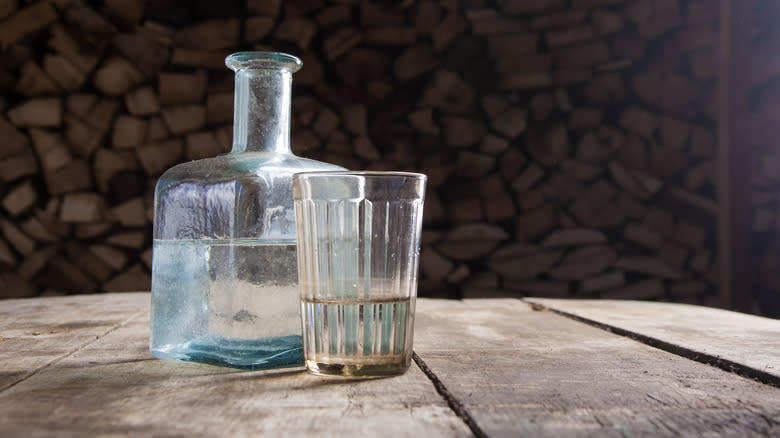
Defined as raw, un-aged, or barely-aged whiskey, white whiskey is a naked spirit made from mostly corn that can be enjoyed as soon as it's distilled — no aging required. Also made from the same ingredients, bottled without aging, and renowned for being incredibly strong, moonshine is a spirit often considered synonymous with white whiskey. While it's true that both appellations are applied somewhat interchangeably as an umbrella term for clear, un-aged spirits made predominantly from corn, a matter of legality is often what decides one label over another.
Though most white whiskeys can also be called moonshine and many moonshines are often referred to as white whiskey, not all moonshines can legally be labeled as white whiskey. There's a very small but important distinction between the two which comes down to a matter of formality in the spirits world, similar to the difference between bourbon and whiskey. But no matter what a distillery chooses to label an un-aged spirit, the rise of moonshine and white whiskey brands has added a new dimension to the spirits scene, creating a new taste for libations straight from the still.
Read more: The Ultimate Vodka Brands, Ranked
What Is White Whiskey?

White whiskey, also sometimes known as "white dog" and virtually synonymous with moonshine, is a clear spirit that can be as strong as 160 proof, which equates to 80% alcohol. Made from the same ingredients as its namesake, white whiskey is essentially an un-aged whiskey that hasn't been given time to mature in a barrel, which is what gives regular whiskey its characteristic color as well as its complex flavor. Eliminating the barrel-aging process makes for a strong but light liquor that has a unique flavor of its own and is adaptable enough to be a versatile base for many cocktails.
Like its fully-aged counterpart, white whiskey can be made from a variety of grains. By legal definition though, white whiskey comes from a mash bill — the mix of grains that get mashed together and distilled into alcohol — consisting mainly of corn, usually 50-80%. Other common grains used in many mainstream recipes include oats, wheat, barley, and rye. The different ratios of different grains give a different taste to whiskey, and the same is true for white whiskey, with each different combination contributing to a diverse array of flavor profiles.
How Is It Made?
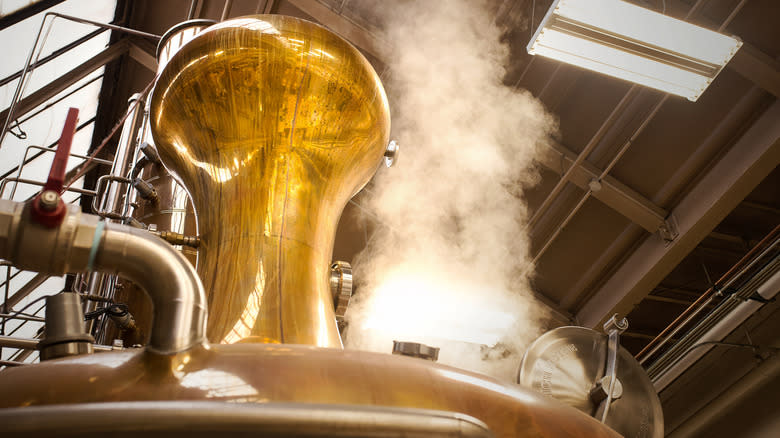
White whiskey is made like many other spirits, in which a mixture of ground grains is boiled in water. Once boiled, yeast gets added to the mixture and the concoction ferments over the course of a few days. White whiskey is made from a different yeast than traditional whiskey or bourbon, because it's not meant to mature as long as these aged spirits. Once fermented, it goes through a copper still, which heats the mixture until the alcohol evaporates, and then the vapors are distilled — cooled until they condense back to a liquid. The final distilled product poured out of the still would normally go into a barrel to age if it was intended to become traditional whiskey, but the white whiskey poured straight from the still is technically ready to bottle.
White whiskey's color and flavor are characterized by its lack of barrel aging, though by legal definition, white whiskey must actually touch the inside of a barrel in order to carry the moniker of whiskey in its name. Many distillers navigate this stipulation with a simple loophole, and keep their white whiskey elixirs in barrels for a mere 24 hours. This accommodates whiskey legalities while still maintaining the purity of white whiskey — a single day in a barrel is a duration short enough that there is little to no impact on the spirit's final flavor.
The Distinction Between White Whiskey And White Dog
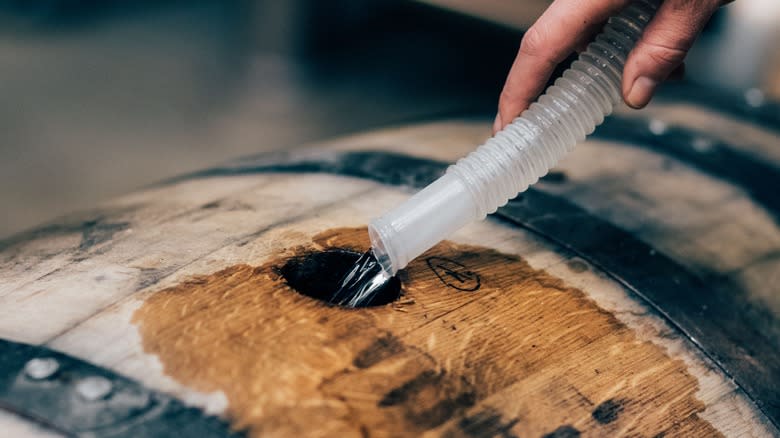
Though white whiskey is also often called white dog, the nickname can be deceptive. There's nothing stopping distilleries from using the labels of white whiskey and white dog interchangeably because, technically, they're the same thing — both are clear spirits that haven't yet aged into proper whiskey.
Specifically, though, white dog is the name for the clear liquid straight from the still that's meant to be poured into barrels to age into whiskey. For this reason, white dog typically consists of a different grain mixture than white whiskey which might not be as palatable when sipped clear, because it's a mash bill intended to mature into something else. White whiskey, on the other hand, is made with the intention of being immediately sippable, so its mash bill is typically selected to be less complex, in order to yield more immediately tasty results that don't need years to mature.
White Whiskey Vs. Moonshine
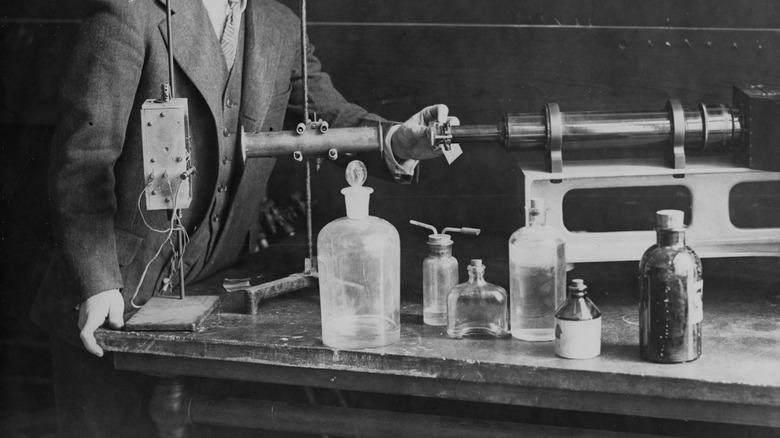
White whiskey and moonshine are, for all intents and purposes, also the same thing. They're different names for the same liquor, a clear spirit made from un-aged grains that's incredibly strong. What differentiates the two is a mere matter of legality. Moonshine is a name that comes with some historical stigma, as it refers to alcohol made illicitly and illegally, whereas white whiskey is made from the same ingredients but completely above board. Many of the legal "moonshines" available for purchase today differ from white whiskey only in that they have not spent a customary 24 hours in a barrel and so, going straight from still to bottle, cannot legally bear the appellation "whiskey".
Moonshine, also sometimes called "white lightning," gets its stigma from the health risks it posed when popularized during Prohibition in the 1920s, when alcoholic drinks in the United States were made illegal. Because Prohibition-era moonshine was often brewed at home and unregulated, it could be dangerous to consume and had a reputation for causing blindness. The blindness came from the presence of methanol, which is a byproduct of any alcohol fermentation and highly toxic in even minuscule amounts. White whiskey, conversely, is made with the proper regulations and removal of methanol during the distillation process. So, though some of today's commercially available white whiskeys are labeled as moonshine, drinking them doesn't pose the same risks as bonafide illegal moonshine, though they should still be enjoyed in moderation.
What Does White Whiskey Taste Like?
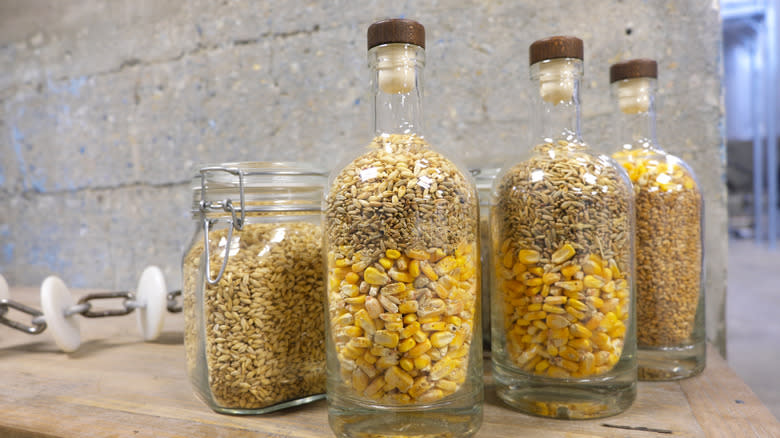
White whiskey and moonshine's flavors are as varied as the distilleries that produce them, and each one differs depending on the combination of grains in the recipe. Without the barrel-aging process, there's no oak infusion to hide anything distasteful in the spirits' naked form. For this reason, distilleries that craft both un-aged and barrel-aged whiskey might not have products of a similar caliber. Flavian Desoblin, owner of the Brandy Library in NYC, hypothesized for Saveur that "good moonshines probably make for bad whiskeys," and vice versa. Gizmodo's Happy Hour article discussing white whiskey echoes similar sentiments, emphasizing that "some are very sweet, some taste like corn on the cob, and some taste like a burnt shoe dunked in tequila."
Any good white whiskey or moonshine will reflect notes of the grains in its make-up. This means that some taste very distinctly of corn, the dominant ingredient which often contributes a degree of sweetness. But the flavor varies with the brand, so a proper introduction to white whiskey or moonshine might require sampling a few distilleries' spirits. Overall, because no white whiskey or moonshine has touched a barrel long enough to alter its pure flavor, the spirits are closer to a glass of vodka than a glass of whiskey, but like whiskey, they're better for sipping than shots.
How Is White Whiskey Served?
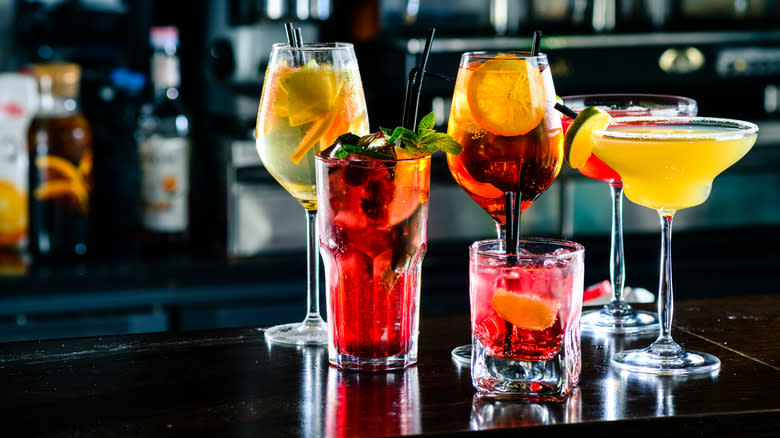
Strong but smooth, moonshine and white whiskey are deemed by many to be best enjoyed like any other whiskey: Served neat, which is to say poured pure and straight into a glass, with no ice or garnishes. While purists might prefer them plain, white whiskey and moonshine have infinite potential for excellent cocktails too. Despite their high alcohol content, these spirits' clear color and un-aged flavor make them a mixologist's tabula rasa. They can be used as an alternative for other clear spirits in mixed drinks and can easily replace gin, vodka, or even tequila in everyone's favorite classic cocktails.
Though white whiskey and moonshine might stray from mixology tradition, their notes of sweetness and grain combine well with a variety of flavor profiles, offering an innovative kick to any traditional cocktail you might want to make a splash with. But because these spirits are a lot stronger than others, ingredient ratios may need to be modified in order to craft a cocktail that's not too overpowering. If you want to stay true to the time period that popularized white lightning, a Bee's Knees made with white whiskey or moonshine would offer a 1920s blast from the past with a citrus twist.
What's Made It Popular?
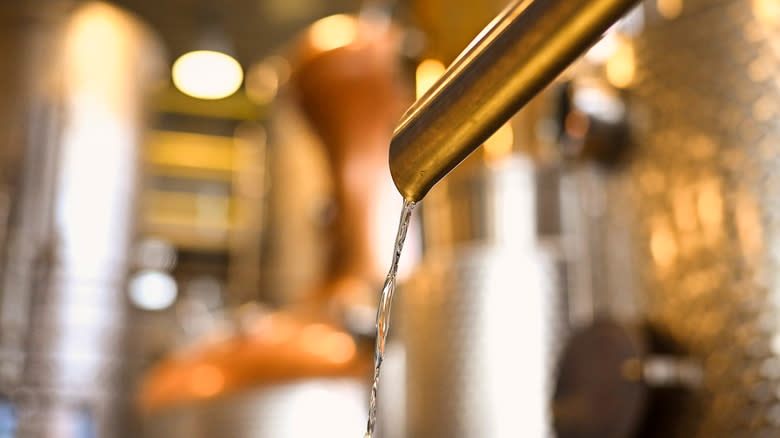
White whiskey's recent popularity, essentially a renaissance of legal moonshine, came about for largely economic reasons. Because white whiskey and moonshine are spirits ready to bottle as soon as they're distilled, they became a practical way for up-and-coming distilleries to manufacture a product that could be put on shelves right away. This was especially useful for smaller distilleries that needed something marketable before their aged whiskies could come of age.
Though bottling white whiskey in addition to aged whiskey proved a nifty way for smaller distilleries to keep business going (or get business started in the first place), the success of white whiskey overall has put more commercial distilleries on the scent. Now, some major whiskey brands also produce a version of un-aged whiskey too. Consequently, the origins of white whiskey's rise to the spirits scene have been mostly for marketing reasons, and less about revived myths, legends, or intrigue. Nevertheless, the proliferation of white whiskey and moonshine brands on the market has also carved out a new niche.
Where To Buy White Whiskey

Since white whiskey and moonshine aren't made illicitly, as in the days of Prohibition, it isn't too hard to find them. Most liquor stores have a brand or two on hand, though more specialty liquor stores are likely to offer a greater variety. Many distilleries also sell their spirits directly on location and online. Plenty of white whiskey and moonshine brands have made a name for themselves, and each name is straight out of bootlegging legend.
Buffalo Trace White Dog is a 125-proof mix of corn, rye, and malted barley. The distillery is already renowned for its unicorn whiskey, but this white whiskey has got some kick too. It's available locally and online. Jeptha Creed is a Kentucky moonshine made from Bloody Butcher, a rare type of red heirloom corn that gives the spirit a signature flavor. JC's 80-proof original moonshine is perfectly sippable, though the distillery also produces flavored moonshines such as cinnamon, blackberry, and apple pie. The brand is available in stores across the Southern U.S., but can also be ordered online with shipping to most states. Popcorn Sutton's Likker is perhaps one of the most authentic moonshines on the market. Named after the Appalachian moonshine legend, this 100-proof spirit is a 100-year-old family recipe but, just like during the days of Prohibition, it's only available locally. If you're really feeling adventurous, you can seek it out at one of four distillery locations in Tennessee.
Read the original article on Daily Meal.

